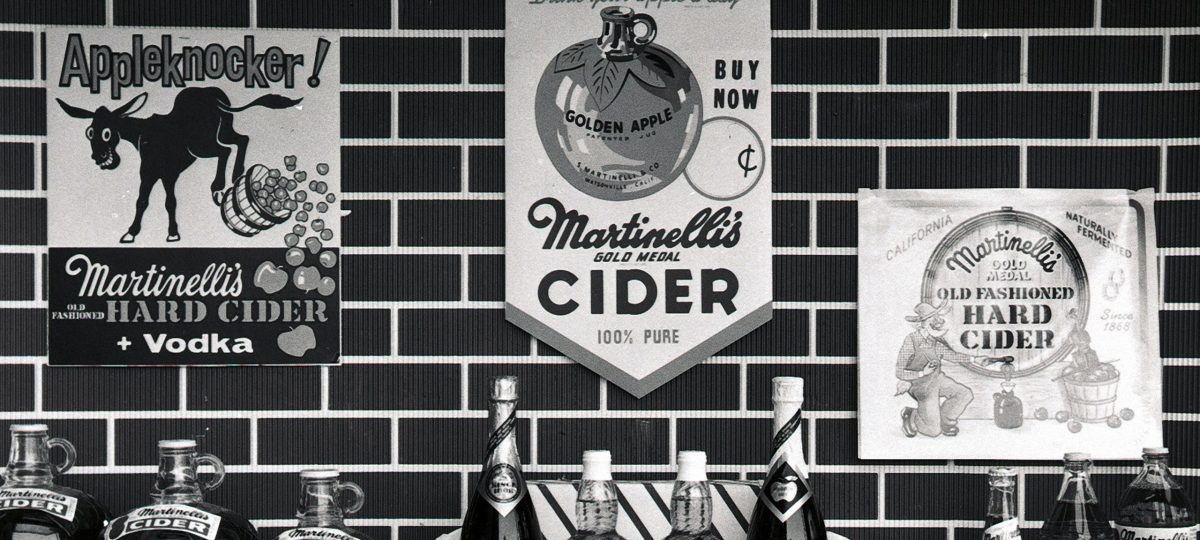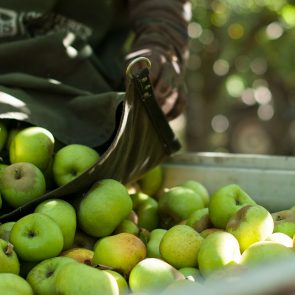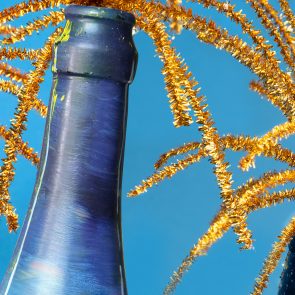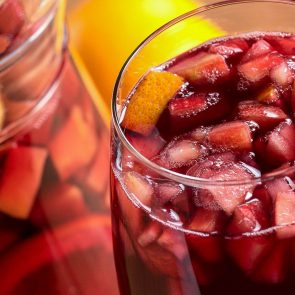When working in archives, you learn that everything tells a story. Not just books, letters, or other documents with readable narratives. Photographs, objects, and even labels can reveal morsels of history. For almost 150 years, Martinelli’s has created bottle labels that represent the company and its traditions. They are often beautiful, memorable works of art, contributing not only to the brand but to its story as well.
Nowadays, product labels have to adhere to legal requirements that include details like nutrition facts, “sell by” dates, alcohol percentages, and recycling information, just to name a few. When S. Martinelli & Co. was founded in 1868, these requirements simply did not exist. As a result, the labels focused mostly on advertising for the company and the product itself.
Back then, the Martinelli’s founders created an award-winning recipe for hard cider. The traditional way to drink apple juice was in fermented form—a process that drew them from Europe to California. Though they weren’t known in Switzerland for making cider, they likely drank it. Cider has a longstanding tradition in Europe, and was a well-established beverage by the time of Charlemagne in the 9th Century. In fact, it’s still prominent in the culinary traditions of Great Britain, Germany, Sweden, and France; and you can certainly find it in Switzerland.
When brothers Stefano and Luigi Martinelli arrived, they Americanized their names to Stephen and Louis and began making soda water, flavored sodas, and fermented cider in Watsonville. We know it was hard cider because apple juice did not yet have a shelf life; therefore, not many people were drinking unfermented juice. And, of course, it said so on the labels. “Extra dry” described a crisp, less-sweet alcoholic beverage.
Our Early Labels

One of Martinelli’s Earliest Labels
After 1890, when Martinelli’s won its first Gold Medal at the California State Fair in Sacramento, the labels proudly displayed the gold medal standard. Martinelli’s cider continued to win medals around the country, and in the early years more medals were added to the labels. This is interesting because label designs often do not include dates unless it’s a “sell by” date. But the pictures of the medals included the year they were won. Another fun fact about these early labels—the historical San Francisco lithography company, Schmitt Label and Lithography Co, printed them.
While this company no longer exists, it is now well known for the clock tower that bears its name on Second and Bryant Streets in San Francisco.
Pre-Prohibition Martinelli’s Labels

Pre-Prohibition era label

Pre-Prohibition era box label
Prohibition-Era Labels
An extremely important era for Martinelli’s was Prohibition, also known as the Volstead Act and the 18th Amendment, which prohibited both alcohol production and sales throughout the United States. It lasted from 1920 to 1933, and completely changed Martinelli’s product lineup. To keep the family business from closing, they concocted a unique, unfermented, and pasteurized sparkling apple juice. Instead of describing the product as “extra dry”, the labels simply said “sparkling apple juice.”

Prohibition-era still label for unfermented, still apple juice

Prohibition-era still label for unfermented, still apple juice Prohibition era label for unfermented, sparkling apple juice

Classic style, Prohibition era label for unfermented, sparkling cider
It’s worth noting that the men who led Martinelli’s back then also designed many of the product labels. In the company archives, we found several sketches created by either Stephen G. Martinelli Jr. or his son Stephen C. Martinelli. Below you can see a side-by-side comparison of the drawings and labels they likely inspired. We also know for certain that Stephen created the hard cider label, known as the “Old Timer,” in the 1960s. This remains one of the most beloved labels today.




Post Prohibition Labels
Hard cider made its comeback after Prohibition ended in 1933, however, Martinelli’s hard cider products and the “Old Timer” label were retired in 1977.


Between the 1950s and 1990s, Martinelli’s underwent various label designs to tell the brand’s “gold standard” story and catch the eye of consumers.
1950s Martinelli’s Labels


1960s Martinelli’s Labels



1960s label, which made a comeback for current 8oz sparkling juice bottles

Current Label
Though label design updates are not expected anytime soon, you never know what the future holds. You can be sure that they’ll always feature the recognizable Martinelli’s logo and the gold medal won way back in 1890. Of course, with a traditional recipe of quality that demands apple juice, Martinelli’s will always be set apart by superior flavor. No matter how they’re labeled!

Current label design
Do you have a question or a favorite label design? Let us know in the comments!





Daniel Lopez
Hello All,
I’ve been collecting Martinelli products for a while now. I have every bottle they ever put out. From 1868 through modern times. I also have some labels that I don’t see here on the site. Reach out to me, I could send over some scans. And I also have the original photo of the famous Martinelli delivery wagon from the early 1900’s. Also have a Medal that was awarded to y guys back in 1906. Hope to hear from y’all
Lindsay
Will you be bringing back any hard cider? I bet it would be amazing!
Dannica
Hi! I was wondering if you had any pictures of the current label that goes on the bottle neck? I would love to use them for a school project!!!
Martinelli's
Hi Dannica,
Yes, we do! What is the best email address to send them to?
Thank you!
richard patterson
I was a big fan of Martinellis’s hard cider…what a shame its no longer available.
Stephanie
Hurry to a Costco in CA, we hv hard cider in liquor area for 14.99!!
Jarviel Rayford
I am super fan of your products from a young man during celebrations and monumental moments with family to my current seasoned grandfather. My family comes to me wondering when will Martinellis come out with a sugar free kind that’s diabetic friendly? I responded I will ask hahahahaha…here I am asking, will you entertain ever making a diabetic friendly product? There is a large diabetic market that is missing your delicious products.
Post a Comment